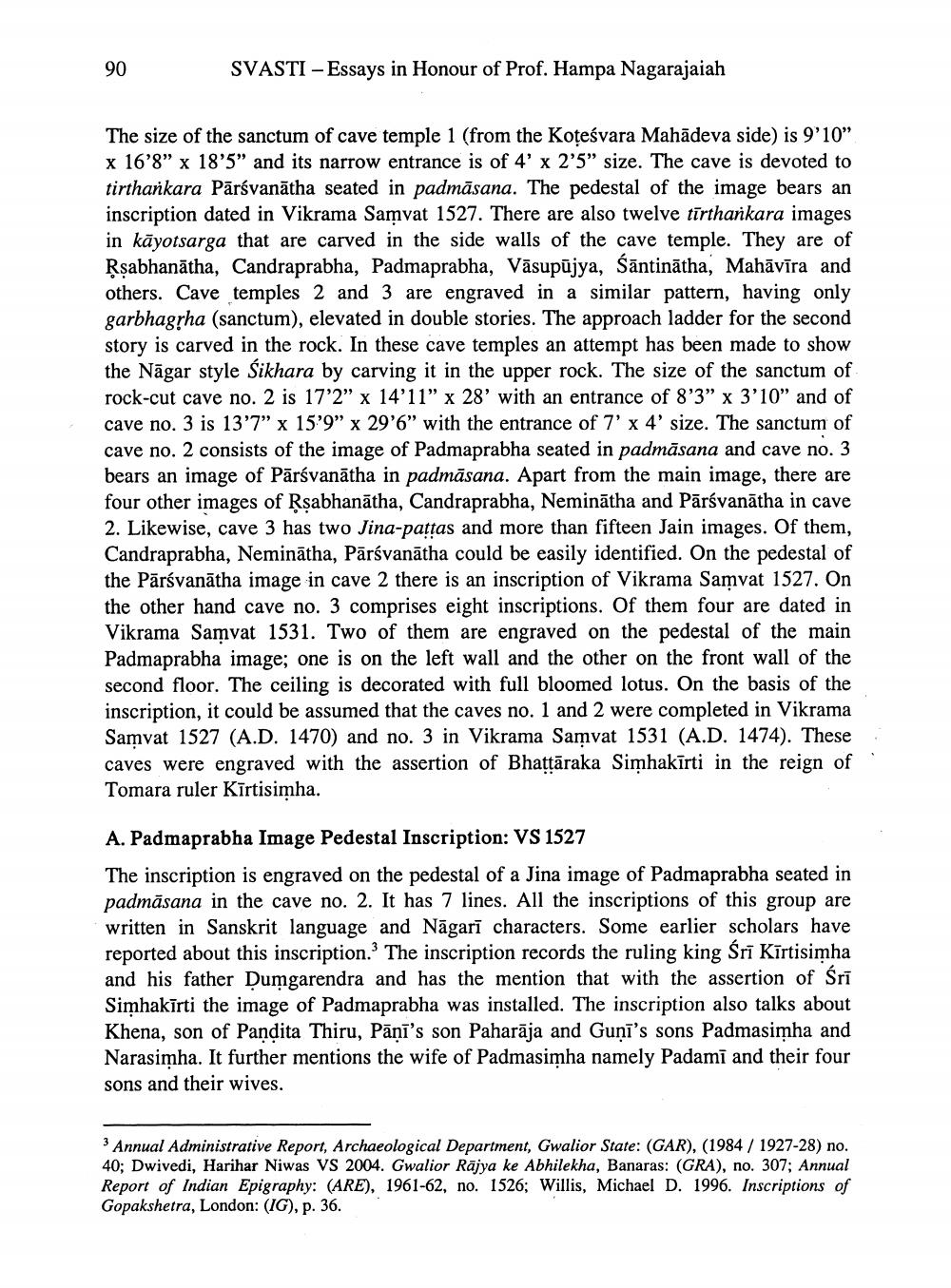________________
90
SVASTI - Essays in Honour of Prof. Hampa Nagarajaiah
The size of the sanctum of cave temple 1 (from the Kotesvara Mahadeva side) is 9'10" x 16'8" x 18'5" and its narrow entrance is of 4' x 2'5" size. The cave is devoted to tirthankara Pārsvanatha seated in padmasana. The pedestal of the image bears an inscription dated in Vikrama Samvat 1527. There are also twelve tīrthankara images in käyotsarga that are carved in the side walls of the cave temple. They are of Ṛṣabhanatha, Candraprabha, Padmaprabha, Väsupüjya, Säntinätha, Mahāvīra and others. Cave temples 2 and 3 are engraved in a similar pattern, having only garbhagṛha (sanctum), elevated in double stories. The approach ladder for the second story is carved in the rock. In these cave temples an attempt has been made to show the Nägar style Sikhara by carving it in the upper rock. The size of the sanctum of rock-cut cave no. 2 is 17'2" x 14'11" x 28' with an entrance of 8'3" x 3'10" and of cave no. 3 is 13'7" x 15'9" x 29'6" with the entrance of 7' x 4' size. The sanctum of cave no. 2 consists of the image of Padmaprabha seated in padmāsana and cave no. 3 bears an image of Pärsvanatha in padmäsana. Apart from the main image, there are four other images of Rṣabhanätha, Candraprabha, Neminatha and Pārsvanatha in cave 2. Likewise, cave 3 has two Jina-pattas and more than fifteen Jain images. Of them, Candraprabha, Neminatha, Pärśvanätha could be easily identified. On the pedestal of the Pärsvanatha image in cave 2 there is an inscription of Vikrama Samvat 1527. On the other hand cave no. 3 comprises eight inscriptions. Of them four are dated in Vikrama Samvat 1531. Two of them are engraved on the pedestal of the main Padmaprabha image; one is on the left wall and the other on the front wall of the second floor. The ceiling is decorated with full bloomed lotus. On the basis of the inscription, it could be assumed that the caves no. 1 and 2 were completed in Vikrama Samvat 1527 (A.D. 1470) and no. 3 in Vikrama Samvat 1531 (A.D. 1474). These caves were engraved with the assertion of Bhatṭäraka Simhakirti in the reign of Tomara ruler Kirtisimha.
A. Padmaprabha Image Pedestal Inscription: VS 1527
The inscription is engraved on the pedestal of a Jina image of Padmaprabha seated in padmasana in the cave no. 2. It has 7 lines. All the inscriptions of this group are written in Sanskrit language and Nagari characters. Some earlier scholars have reported about this inscription.' The inscription records the ruling king Śrī Kirtisimha and his father Dumgarendra and has the mention that with the assertion of Śrī Simhakirti the image of Padmaprabha was installed. The inscription also talks about Khena, son of Pandita Thiru, Pani's son Paharaja and Guni's sons Padmasimha and Narasimha. It further mentions the wife of Padmasimha namely Padami and their four sons and their wives.
3 Annual Administrative Report, Archaeological Department, Gwalior State: (GAR), (1984/1927-28) no. 40; Dwivedi, Harihar Niwas VS 2004. Gwalior Rajya ke Abhilekha, Banaras: (GRA), no. 307; Annual Report of Indian Epigraphy: (ARE), 1961-62, no. 1526; Willis, Michael D. 1996. Inscriptions of Gopakshetra, London: (IG), p. 36.




